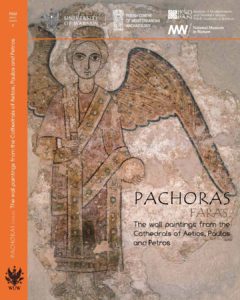-
BUY ONLINE
-
Stefan Jakobielski (ed.), Pachoras. The Wall Paintings from the Cathedrals of Aetios, Paulos and Petros (=PAM Monograph Series 4), Warsaw: PCMA UW, IKŚiO PAN, MNW, WUW
Warsaw 2017
ISBN 978-83-942288-7-3 (print)
ISBN 978-83-235-3236-1 (online)
https://doi.org/10.31338/uw.9788323532361
474 pages
Soft cover with flapsThe catalogue of wall paintings from the cathedral in Faras, published by the Polish Centre of Mediterranean Archaeology University of Warsaw, is the second part of a scientific publication of an early Christian cathedral uncovered in 1961–1964 by a Polish team of archaeologists headed by Prof. Kazimierz Michałowski. The discovery was made as part of the Nubian Campaign, a UNESCO-led program of archaeological salvage operations put into motion by the construction of the Great Aswan Dam.
The first volume authored by Włodzimierz Godlewski, entitled Pachoras. The Cathedrals of Aetios, Paulos and Petros. The Architecture, presented the architecture of the cathedral, whereas the second volume concerns the wall paintings from the interior of this building, saved only by a great effort of Polish archaeologists and restorers, most of them from the National Museum in Warsaw.
“The discovery of the cathedral in Pachoras is considered among the greatest archaeological discoveries of the 20th century. It revolutionized knowledge of the Middle Nile Valley in post-antique times. The Christian kingdoms of Nubia appeared in entirely new light, bringing new historical data on the history of the Church in Nubia and its connection with the rest of the Christian world. A new scientific discipline was born, Nubiology, and Warsaw became its world center,” writes Prof. Adam Łukaszewicz from the University of Warsaw in his review of the book, highly rating this new and complete synthesis of the murals written and edited by Stefan Jakobielski, a Nubiologist of world repute, one of the few still active members of the original excavation team that had worked in Faras.
The study was written by Jakobielski (introduction, architectural resumé and his main theme, the chronology of the murals) with Małgorzata Martens-Czarnecka adding a chapter on the manner of the painting. The main body of the volume is composed of a catalogue of 154 paintings, the descriptions of which were written by both the mentioned authors collaborating with Bożena Mierzejewska, Bożena Rostkowska and Magdalena Łaptaś (representing at the time the Research Centre for Mediterranean Archaeology, now Institute of Mediterranean and Oriental Cultures of the Polish Academy of Sciences, like the first two authors, and the National Museum in Warsaw). The entries give an overview of all the essential metric data as well as location, inventory numbers and state of preservation.
The descriptions follow a set scheme: composition, dress and ornaments, attributes and coloring, ending in a commentary discussing the interpretation of the scene or motif. Inscriptions, wherever present, are treated separately, presenting a transcription and translation, all by Jakobielski, revised by Adam Łajtar. A set of references updated to 2015 has been presented with each entry. The murals are illustrated richly with field photos of the paintings before they were taken down from the cathedral walls and post-conservation images (recently repeated at the National Museum in Warsaw for the part of the collection prepared for display in the recently opened new Faras Gallery). The interpretation of the murals is enhanced by some remarkable and well researched drawings made by experienced documentalists from the Polish Centre of Mediterranean Archaeology. The volume was edited by Jakobielski. The concept of the catalogue presentation was prepared by Iwona Zych. It includes a chronological overview of all the paintings on a foldout timeline, a series of drawings of the walls of the cathedral presenting the location of all of the murals and a table of all the ornamentational motifs, patterns and pattern repeats, plates collecting comparative drawings of the bishops of Pachoras, kings of Makuria and Nubian dignitaries in their robes, accompanied by appropriate and relevant indices and concordance tables, all of which provide students of the wall paintings with the very essential tools for their understanding and interpretation.
The monograph covers all of the paintings that were recorded on the walls of the cathedral and it is more than just a catalogue of the individual murals held by the National Museums in Khartoum and Warsaw. It also includes paintings that were not removed from the walls of the cathedral and, after the submerging of the site in the waters of the dam lake, no longer exist. The publication is therefore, “sui generis an inventory of the wall paintings decorating once the walls of the now submerged cathedral,” sums up Łukaszewicz in his review.
The volume is intended for researchers, specialists in medieval Nubian Christian wall painting. The quality of the illustrations and the extensive documentation based on a minute examination of the original murals and their photo images will make it an excellent tool for further research in the field and interpretation of the Faras collection.
For download:
-
- About the book
- Contents
- Introduction
-
